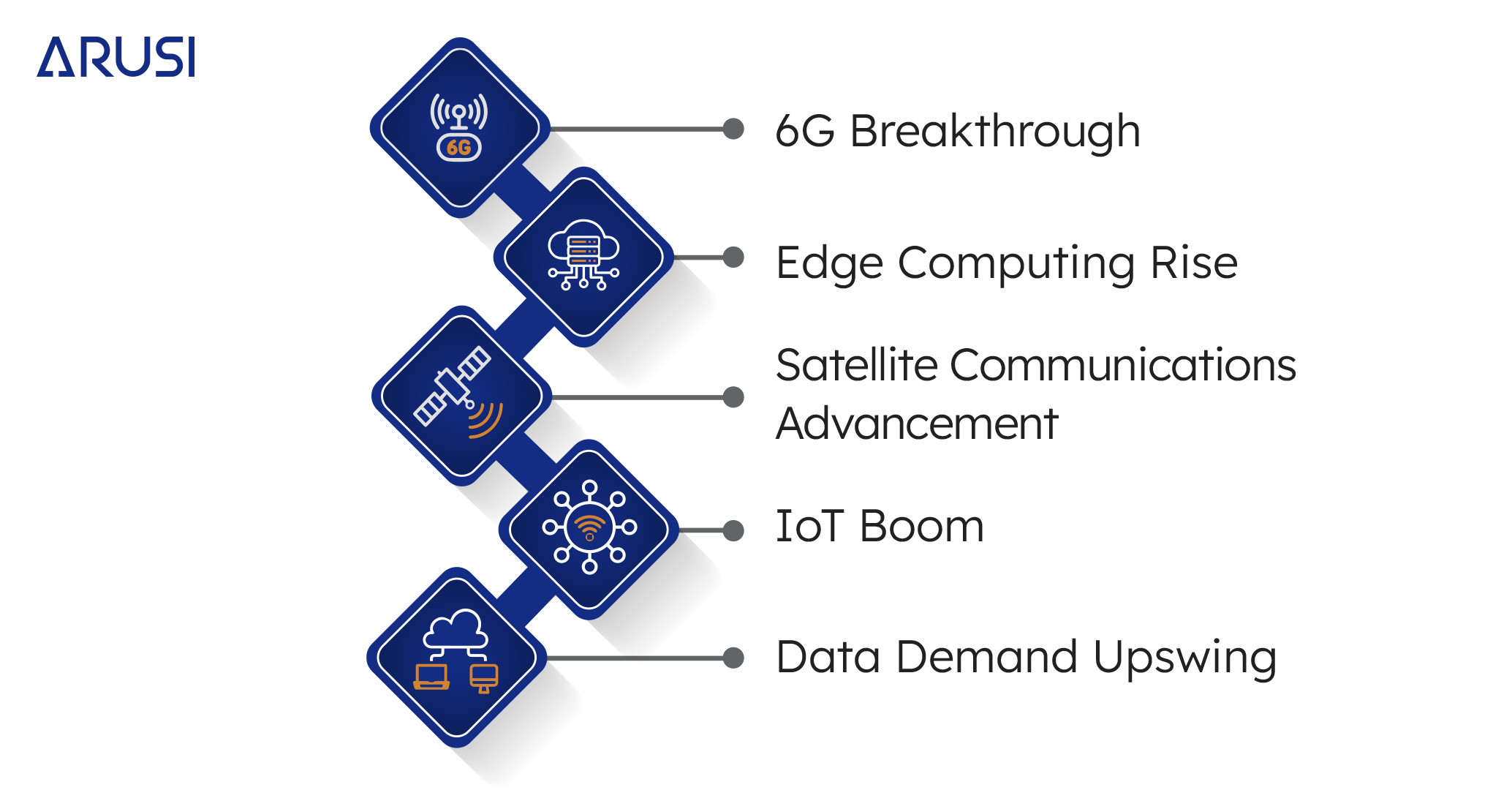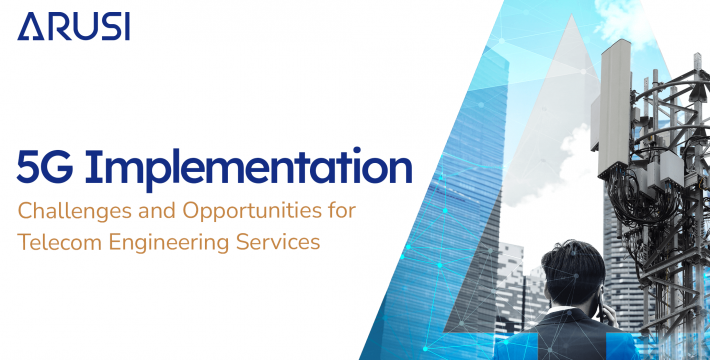5G, or fifth-generation technology, is a big change for wireless connection. It has never-before-seen speeds, less delay, and the ability to connect a lot of devices at once.
5G will change industries like healthcare, cars, entertainment, and manufacturing by letting people talk and share data in real time like never before. It will also make it easier for people and businesses to connect.
Growing demand for 5G implementation in the telecom industry
With an anticipated global revenue of $667 billion by 2026, the telecom industry is under increasing pressure to meet the growing demand for 5G technology. Consumers expect enhanced mobile experiences, businesses are looking for more robust connections, and governments view 5G as a vital component for future economic growth.
Challenges in 5G Implementation
Spectrum and regulatory constraints
Limited spectrum availability for 5G deployment: The bandwidth required for 5G’s enhanced performance is in short supply, leading to auctions and competition among telecom operators, often at exorbitant prices.
Government regulations and licensing issues: Different countries have unique regulations concerning the implementation of 5G. Meeting these regulatory requirements is often a complex and time-consuming process.
Infrastructure requirements
Need for denser small-cell networks: Unlike traditional macro cell towers, 5G demands a dense network of small cells. Installing these small cells requires careful planning and significant capital investment.
Upgrading existing infrastructure for 5G compatibility: Many existing telecom infrastructures are incompatible with 5G. Upgrading to 5G requires not only financial investment but also sophisticated engineering skills and resources.
Interoperability and standardization
Ensuring seamless integration with existing networks: 5G networks must work with current 4G and 3G networks. This necessitates significant technological finesse and may lead to implementation delays.
Addressing global standardization challenges: Creating universal standards for 5G across different regions is a complex challenge that requires international collaboration and agreement.
Security concerns
Vulnerabilities in 5G networks and potential cyber threats: The complexity of 5G architecture leads to potential vulnerabilities. Telecom providers must invest in cutting-edge security measures to mitigate cyber threats.
Implementing robust security measures for data protection: Protecting user data within the 5G network requires a multifaceted security strategy, involving encryption, authentication, and ongoing monitoring.
Opportunities for Telecom Engineering Services
Network Planning and Optimization
Utilizing AI and big data analytics: By leveraging AI and big data, telecom providers can analyze network performance in real-time, automating adjustments to meet demand.
Optimizing coverage and capacity: 5G networks require continuous monitoring and optimization to ensure they meet performance standards, opening up opportunities for specialized services and technologies.
Infrastructure Development
Building and deploying 5G-compatible infrastructure: Technologies like Massive MIMO and beamforming are essential for 5G performance, requiring specialized equipment and expertise.
Leveraging innovative technologies: Telecom engineering services must embrace and innovate with the latest technologies to build and maintain effective 5G networks.
IoT Integration
Exploring the potential of the Internet of Things (IoT) in the 5G era: With increased capacity and lower latency, 5G enables new IoT applications, from smart homes to connected industries.
Creating smart cities and industries: 5G facilitates the connectivity that smart cities and modern industries require, enabling more efficient, responsive environments.
Edge Computing Solutions
Implementing edge computing to reduce latency: By processing data closer to the source, edge computing improves response times, crucial for applications like autonomous driving and remote surgery.
Enabling new applications and services: Edge computing under 5G can support real-time analytics, augmented reality, and other applications that require instant data processing.
Collaboration with Industry Verticals
Collaborating with industries like healthcare, automotive, and entertainment: Specific 5G solutions can be tailored to meet the unique needs of different industries, enabling new services and efficiencies.
Tailoring 5G solutions: Working closely with industries to design bespoke 5G solutions will drive innovation and adoption.
Telecom operators that overcame challenges
Operators like Verizon in the U.S. have overcome regulatory and infrastructure challenges to successfully deploy 5G in several cities. In South Korea, SK Telecom’s aggressive 5G strategy has resulted in widespread coverage.
Showcasing innovative telecom engineering services
Innovative deployments, such as the use of 5G for remote medical consultations, demonstrate how telecom engineering services can meet specific industry needs. The UK’s 5G RuralFirst project exemplifies how 5G can bring connectivity to remote areas, fostering economic development and social inclusion.
Collaborative Efforts in Research and Development
Many telecom operators are engaging in collaboration with universities, tech companies, and government agencies for cutting-edge research in 5G technology. Collaborative research is playing a crucial role in overcoming the limitations and maximizing the potentials of 5G.
Navigating the Future of Telecom Industry Trends
In the rapidly evolving landscape of the telecom industry, technological innovations are shaping the way we communicate, work, and entertain. As highlighted in our recent infographic on “5 Telecom Industry Trends to Watch in 2024”, the onset of 6G stands as a monumental testament to the ever-accelerating pace of wireless communication evolution.
Promising speeds that dwarf its predecessor, 6G is set to redefine connectivity. But it’s not alone. The rise of edge computing promises to decentralize data processing, fundamentally transforming user experiences by significantly reducing latency.
Meanwhile, advancements in satellite communications are paving the way for unprecedented remote broadband internet access. With the imminent IoT boom, the number of connected devices is predicted to explode, presenting both challenges and opportunities for telecom providers.
As the digital realm continues to expand, there’s an insatiable upswing in data demand, pressing telecom providers to not just meet this rising demand, but also ensure the utmost quality and reliability. Dive deeper into these trends with our embedded infographic below and join us in exploring the exhilarating future of telecom.

Future Outlook for Telecom Engineering Services
Anticipated advancements in 5G technology
5G technology will continue to evolve, with improvements in efficiency, speed, and reliability. Research into areas like Quantum Communication and Holographic Connectivity will bring even more innovation.
Preparing for 6G and beyond
While 5G is still in its early stages of deployment, research and discussion around 6G have already begun. 6G is expected to bring more advancements, like enhanced integration with AI, improved energy efficiency, and potential data speeds up to 1 Tbps.
Addressing potential challenges and opportunities in next-generation networks
Ongoing research, investment, and innovation will be key in facing the potential challenges in next-generation networks, including energy consumption, security, and global standardization.
Conclusion
Telecom engineering services are not only essential for the current deployment of 5G but will also be instrumental in guiding the technology to its full potential, shaping the future of communication.
As we continue to embrace 5G and look towards 6G, it’s essential for all stakeholders, from governments to industry players, to invest in research, collaboration, and innovation. By fostering a dynamic, responsive approach, we can ensure that the telecommunications landscape continues to drive technological advancement, fulfilling societal needs and sparking global growth.
By expanding on the existing points, this blog provides a comprehensive overview of the subject, encapsulating the multifaceted nature of 5G implementation and the pivotal role that telecom engineering services play in this field. It underlines the importance of continued innovation, collaboration, and adaptability in shaping the future of telecommunications.
